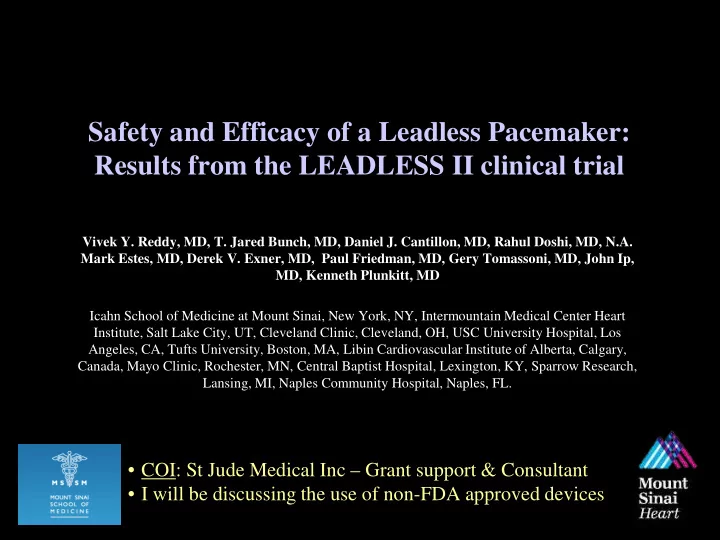

Safety and Efficacy of a Leadless Pacemaker: Results from the LEADLESS II clinical trial Vivek Y. Reddy, MD, T. Jared Bunch, MD, Daniel J. Cantillon, MD, Rahul Doshi, MD, N.A. Mark Estes, MD, Derek V. Exner, MD, Paul Friedman, MD, Gery Tomassoni, MD, John Ip, MD, Kenneth Plunkitt, MD Icahn School of Medicine at Mount Sinai, New York, NY, Intermountain Medical Center Heart Institute, Salt Lake City, UT, Cleveland Clinic, Cleveland, OH, USC University Hospital, Los Angeles, CA, Tufts University, Boston, MA, Libin Cardiovascular Institute of Alberta, Calgary, Canada, Mayo Clinic, Rochester, MN, Central Baptist Hospital, Lexington, KY, Sparrow Research, Lansing, MI, Naples Community Hospital, Naples, FL. • COI: St Jude Medical Inc – Grant support & Consultant • I will be discussing the use of non-FDA approved devices
Today’s Leadless Pacemaker System The Nanostim Device • Percutaneous femoral vein delivery - 18F introducer /steerable catheter - <30 minute skin-to-skin procedure • Self-contained device in ventricle - No lead or surgical pocket - Inherently MRI compatible • Conventional Features -Temperature-Based Rate Response - >10-yr battery life - Hysteresis - Magnet Mode • Flexible replacement options - Catheter-based retrieval - Deliver additional leadless pacemakers - Revert to conventional pacing lead Proprietary and Confidential 3
Leadless II Clinical Trial Overview • Prospective, multicenter, non-randomized, FDA IDE study • Objective: – To evaluate the clinical safety and efficacy of non-surgical implantation of the leadless cardiac pacemaker in patients indicated for a VVI(R) pacemaker. • Primary Cohort: 1 st 300 patients followed for 6mo (June 2015) • Total Cohort: All patients enrolled by June 2015 (n=526) • Primary Endpoints (by ITT): – Safety: Freedom from Serious Adverse Device Effects at 6 months – Efficacy: Acceptable pacing capture threshold (d2.0 V at 0.4 msec) and a therapeutically acceptable sensing amplitude (R wave e5.0 mV, or a value equal to or greater than the value at implantation) through 6 mo. • 56 Centers in the US, Canada and Australia – 100 Operators (only one had prior experience with leadless pacing)
Leadless II Clinical Trial Outcomes • Device was successfully implanted in ~96% of patients • Primary Safety Endpoint (Intent-to-Treat Analysis) – 280 of the 300 patients achieved endpoint (93.3%; 95% CI = 89.9 to 95.9) – This exceeded the performance goal of 86% (P<0.001) • Primary Efficacy Endpoint (Intent-to-Treat Analysis) – 270 of the 300 patients achieved endpoint (90.0%; 95% CI = 86.0 to 93.2) – This exceeded the performance goal of 85% (P = 0.007) • Efficacy (Successful implants) – 289 patients with successful device implant – 270 of the 289 patients achieved endpoint (93.4%; 95% CI = 89.9 to 96.0) – This exceeded the performance goal of 85% (P <0.001) • Based on device-use characteristics, the battery longevity is estimated to be 15.0 ± 6.7 yrs (95% CI, 14.2 to 15.8 yrs)
Leadless II Clinical Trial Device-Related SAEs 4 4 1.3 8 8 1.5 4 4 1.3 6 6 1.1 2 2 0.6 3 3 0.6 * 3 3 0.9 10 10 1.9 * * Includes: ischemic stroke, angina pectoris, pericarditis, acute confusion & expressive aphasia, dysarthria & lethargy post implant, contrast induced nephropathy, orthostatic hypotension with weakness, left leg weakness during implant, probable pulmonary embolism, ischemic stroke
Leadless II Clinical Trial Conclusions • The Leadless Pacemaker was successfully implanted in ~96% of attempted patients. • The trial met the pre-specified Safety and Efficacy endpoints Complication rate similar to that seen with conventional pacemakers Complication rate likely to improve with operator experience (Rem: in this study, 99 of 100 operators had never implanted a leadless device) • The device was shown to be retrievable in a subgroup of patients (n=7) who needed a replacement (Time from implant = 160±180 days; Range = 1 to 413 days) • The estimated device longevity based on the 6-month follow- up duration is encouraging
Leadless II Clinical Trial Limitations An Observational study (not Randomized) Mean Follow-Up of only 6 months How to manage device after battery depletion? Possible to retrieve after ~1 year, but what about 5, 10, 15 yrs? o Retrieval vs Abandonment o Limited device diagnostics (eg, no electrogram data) Large venous sheath (18Fr) Now increasingly common used for cardiology procedures o Low observed rate of hematomas o Single ‐ chamber (RV) pacing only Device-to-device communication is in development o Would lead to dual-chamber, CRT, etc o
Recommend
More recommend